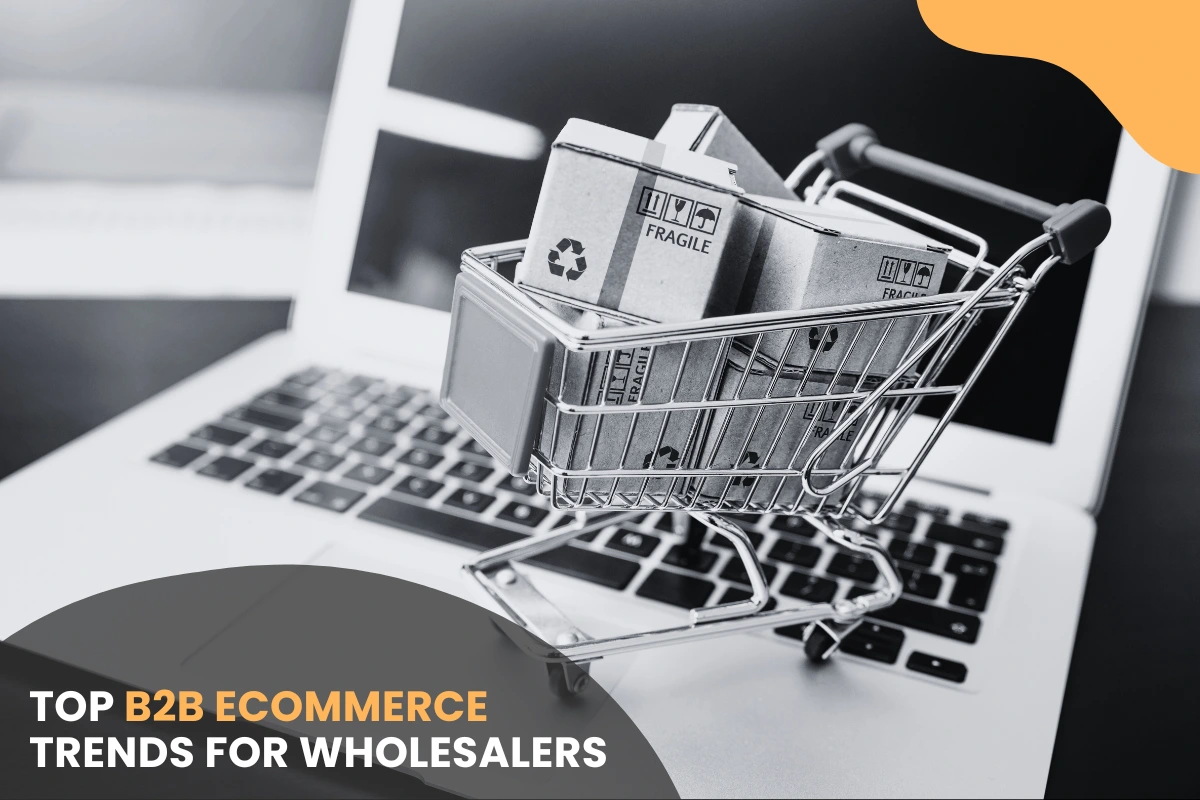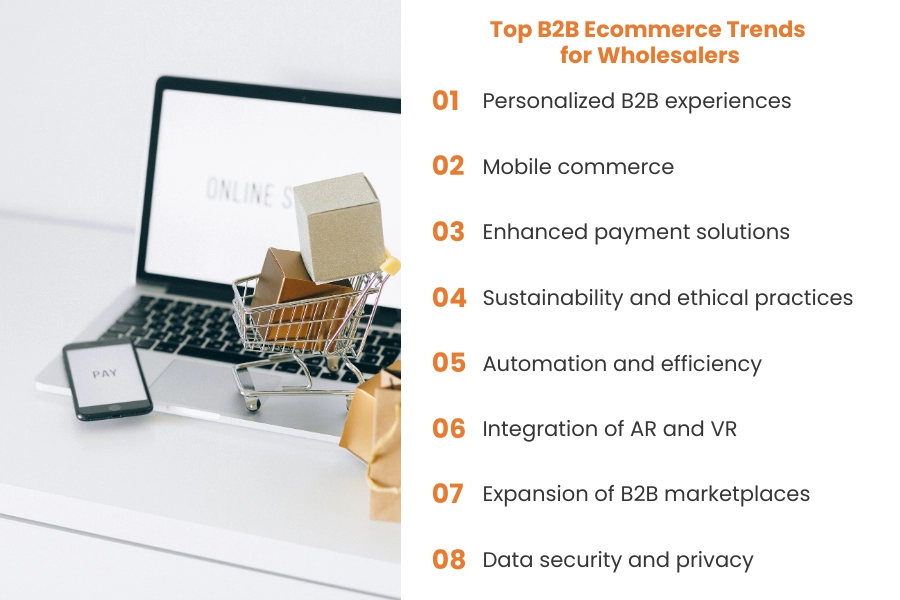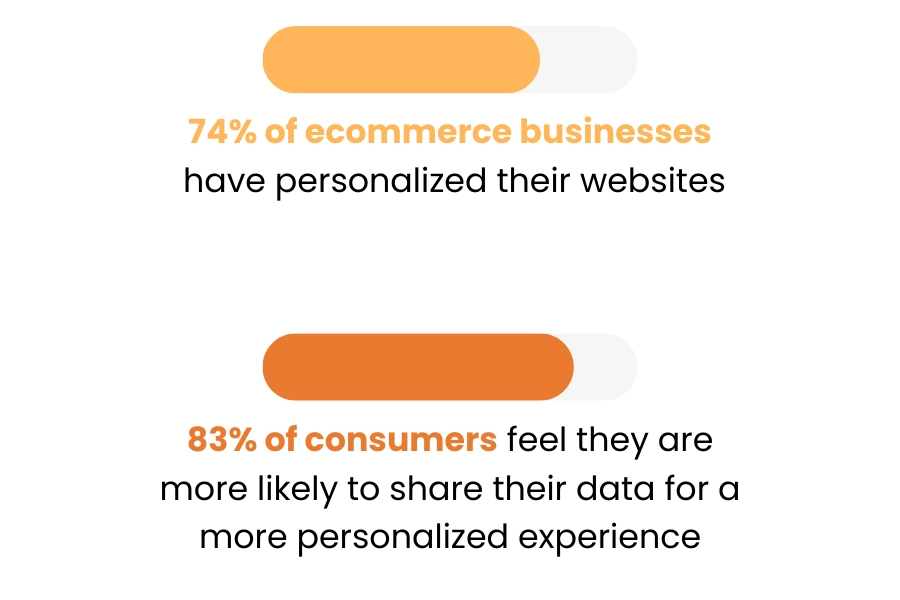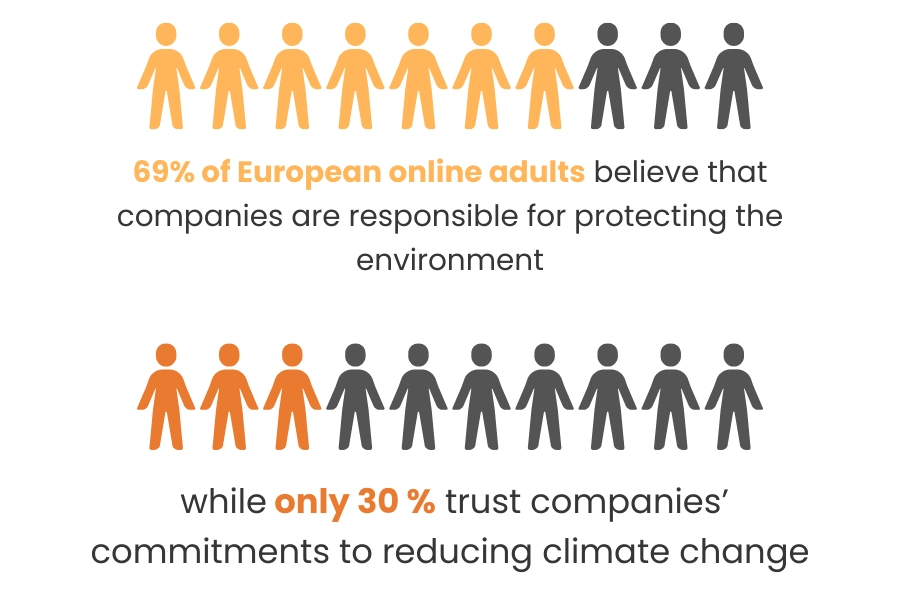Top B2B Ecommerce Trends for Wholesalers
Updated on
April 22, 2024
by
Mike Foster

Wholesale companies buy goods in bulk from manufacturers or distributors and sell them to retailers and sometimes the public. Because of bulk buying, wholesalers get their products at discounted prices and can pass specific discounts on to retailers they have been dealing with over time.
Historically, transactions took place over the phone or in meeting rooms where wholesalers and retailers would get together, discuss the terms of the sale, and enter into lengthy contracts.
With commerce today, wholesalers have a wider global reach and can market themselves on multiple online platforms.
Jump to the most relevant trend:
- Personalized B2B experiences
- Mobile commerce
- Enhanced payment solutions
- Sustainability and ethical practices
- Automation and efficiency
- Integration of AR and VR
- Expansion of B2B marketplaces
- Data security and privacy
Transitioning from manual trade to buying on commerce platforms has been challenging for business owners. Reports of dysfunctional web stores tend to put buyers off, but on the whole, the industry is booming, and the competition is stiff. You must embrace commerce technology so that you remain competitive and profitable.
We share some helpful insights on the latest B2B ecommerce trends for wholesalers that will inspire you to get the most out of your commerce systems.

Trend 1: Personalized B2B experiences
Providers of B2B platforms realize that their success lies in catering to their customer preferences and behaviors and that their platforms should identify with those interests.
Knowing your customers and delivering a relevant and accurate buying experience takes time and hard work, but it should ultimately place your buyer first and increase conversion rates.
It’s about delivering the right message to the right person at the right time; however, this is easier said than done. Questions to ask yourself are:
How will personalization contribute to delivering value?
It should be behavior-based and can be personalized according to buyer groupings.
Where in the B2B cycle will personalization be most effective?
Research conducted by Forrester indicates that personalization close to the purchase and post-sale stages has the most impact on an organizational level.
How to personalize your platform?
There is more to personalization than just the sequencing of products or delivery mechanisms. Pay attention to tone, style, headlines, and visuals. Beginning with a broad personalization, you can move through to a more individual variation and, finally, to a one-on-one level.
Where and how should you deploy personalization?
The merging of audience data into categories and further analysis will enable you to identify when and where to trigger personalization techniques based on the knowledge of your audience.
Measurement of personalization success and returns
Short-term activity results are a good start; however, longer-term interactions and conversions will give a more comprehensive and accurate view of personalization success.
According to a recent study, 74% of commerce businesses have personalized their websites, with an average increase of 10 and 15 percent in revenue due to personalization.
83 percent of consumers feel they are more likely to share their data for a more personalized experience. If you haven’t yet incorporated personalization into your commerce platform, now may be a good time to investigate this option so that you can maintain a competitive edge in the market.

Trend 2: Mobile commerce
Many wholesale customers don’t have time to sit at their desks for long periods. If they know what products they need and the prices, they prefer to do business on their mobile phones.
For busy B2B customers, omnichannel mobile apps that allow them to request notifications when particular stock items come in, upload product data, bid online using their mobile auction facilities, scan barcodes, and approve quotes on the run will simplify their busy lives and empower them to conduct business at any time, from mostly any location.
You can only afford to be with a B2B mobile application today. Mobile apps improve the user experience by providing increased accessibility, enhanced communications between you and your customers, and personalized customer experiences.
These features give you an essential competitive advantage in today’s business climate.
Trend 3: Enhanced payment solutions
Making payments in the wholesale industry is more complex than doing an EFT at the time of checkout.
Manufacturers and wholesalers negotiate deals, and the wholesalers, in turn, pass discounts on to their customers. Discounts vary and are not always available at the point of sale.

Redundant or obsolete stock is sometimes returned at a different cost than the customer bought, so a straight credit doesn’t always work. Some manufacturers give rebates based on bulk sales to specific outlets, allocating credits to the customer’s account.
In these environments, accounts are often reconciled at the end of the month, and a single payment is made monthly. commerce platforms need flexibility in providing individual customer terms, discounts, rebates, and buying on credit.
For the rest, however, smaller customers who don’t buy bulk quantities or don’t qualify for credit facilities, a robust payment system needs to be in place.
According to a document released by Worldpay, digital wallets are the preferred payment method, accounting for 50 percent of global commerce spending in 2023 and 30 percent of POS spending.
In card-saturated markets such as the US and UK, card spending has shifted to digital wallets such as Apple Pay, Google Pay, and PayPal. However, in many other European and Asian markets, account-to-account (A2A) payments still dominate and receive strong government support and bank collaboration.
Worldpay predicts that digital wallets are set to dominate the markets across the globe by 2027. As smartphone manufacturers, banking networks, and commerce marketplaces compete for a share in the e-wallet market, applications abound on technology platforms worldwide, and leading global commerce sites have their own e-wallet solutions. A good example of this is Amazon Pay and Rakuten Pay.
QR payments are another cost-effective option for merchants and are widely used in Southeast Asia, where central banks provide the required infrastructure, reducing the need for cash.
Credit and debit cards have lost share to digital wallets in recent years. However, they still retain their significance in the markets as e-wallets are generally funded by these cards.
Buy Now Pay Later (BNPL) companies faced rising interest rates and regulations in 2023; however, consumers embraced these methods, and a CAGR of 9 percent has been for global growth through to 2027.
Find out what your customers want and what suits your business best, and when it comes down to choosing a commerce platform, a flexible payment system should be at the top of your list.
Trend 4: Sustainability and ethical practices
As we sit behind a computer screen or mobile app and do our monthly grocery shop online, we like to think that we are doing our bit for the environment by not physically driving out to fetch the goods.
The fact remains, however, that for every item bought, a truck, plane, or ship has been involved in the delivery process. As commerce increases, so will the impact on our environment.
Sustainability in the wholesale environment can include using eco-friendly packaging and streamlining processes such as efficient shelf organization, cutting down on forklift movement, and reducing fuel usage. On a larger scale, delivery route optimization and vehicle checks have a huge impact on fuel consumption and carbon emissions.
An Analytics Consumer Technographics Benchmark Survey by Forrester in 2021 indicates a definite awareness of consumer impact on climate change, with people needing to understand the effects of their online shopping on the environment and requiring transparency from their retailers and brand manufacturers.
Yet, consumerism drives product sales. Despite the growing awareness, a more recent survey shows that a large percentage of consumers remain skeptical about manufacturers’ claims of sustainability as well as the effectiveness of the products. Barriers to sustainable shopping also include pricing and convenience.

Is it up to manufacturers, wholesalers, and retailers to nudge consumers toward sustainability? It can’t do any harm.
However, transparency and making your efforts toward sustainability known to your customers is essential. Your choices in sustainability and ethics may just be the deciding factor when customers choose which wholesaler to support.
Trend 5: Automation and efficiency
Tedious manual processes are now a thing of the past as commerce has streamlined inventory and warehouse management, documentation processes, and financial transactions.
Employees have more time to focus on customer service and sales. There may still be a manual process involved in obtaining approval for quotes, but once the quote has been drafted and approved, it can be converted into an order with the click of a button.
These factors result in improved operational efficiency, which in turn means savings on resources and expenses that can be plowed back into warehouse expansion, increasing your fleet of vehicles, or upgrading your warehouse or fleet management technology.
commerce platforms also facilitate data storage and analytics functions, enabling management to drill down into customer and product statistics and make informed decisions around future purchases and stock holdings.
When customers buy online, you get insights into which products they view, seasonal or monthly preferences, how many potential customers left your website (bounce rate), and how many followed through.
Trend 6: Integration of AR and VR
Augmented reality (AR) is an interactive experience that adds digital content to real-world scenarios with the aid of images, sounds, and texts that can be viewed through a device like a smartphone or headset.

Virtual reality (VR) uses 3D technology to simulate a simulated environment that can be experienced through a headset or controller.
These two technologies enhance customers’ commerce experiences in different ways and secure higher conversion rates. They help customers to learn more about their products through visualization and interaction in a 3D space.
Customers can scan barcodes for more information and give voice commands when completing transactions. VR allows customers to interact with product options and compile their stock bundles.
Customers are offered discounts and vouchers and are encouraged to buy more products. These technologies improve the customer experience and streamline the buying process for busy retail organizations.
AR and VR also enhance the after-sales service and support experience by enabling customers to find product tutorials and instructions online, as well as to join online communities and activities. Both technologies can be employed in the feedback process by collecting data and enabling businesses to assess the success of their products.
Trend 7: Expansion of B2B marketplaces
Online marketplaces enable businesses to expand their local and global options and streamline their operations. Through doing business with B2B commerce platforms, retailers and their customers get access to new markets and new business opportunities.
By using commerce marketplaces, B2B organizations gain access to huge commercial networks and can better showcase their products and reach their target audiences more effectively. Statistics show that B2B organizations adopting commerce technology have experienced an average of 20 percent revenue growth and a 25 percent increase in profitability.
Trend 8: Data security and privacy
Compliance with customer privacy and data security regulations is particularly important in commerce environments, not only from a statutory point of view but also from a customer comfort perspective.
Many customers won’t shop on a site they don’t trust and won’t recommend the site to friends if they have any doubts about its security.
Check the laws in your country, state, and local municipality to ensure you comply. However, whether your country has put regulations in place or not, you want your customers to have peace of mind while shopping online.
Consider adding a privacy policy to your website. The EU’s GPDR legislation is widely used, and many commerce privacy templates are available.
When collecting customer data, transparency is the best policy, and where possible, give them access to delete or change their information.
- Declare your cookie policy and give them options to state their preferences.
- Declare any information sharing or third-party access to information, such as Google AdSense or YouTube.
- Declare the use of retargeting or remarketing tools.
- Give them the option of opting out of providing information.
When it comes to creating a privacy policy, there are templates out there that you can use; however, it is advisable to employ the services of a lawyer who knows the nuances of your business and who will include items that may not occur to you.
Your privacy policy and terms should be visible to your customers and accessible with a button.
Conclusion
If you’re paying for an ecommerce platform to drive your business, leverage its functionality to the fullest.
Advanced data analytics, personalization, and state-of-the-art payment options will project your organization as an ecommerce provider that has your customers’ best interests at heart.
Show customers you care with useful apps that will make their lives easier when transacting with you, and assure them of your trustworthiness by implementing safety and privacy policies.
And lastly, impress them with your quest to provide eco-friendly and sustainable options whenever possible.




